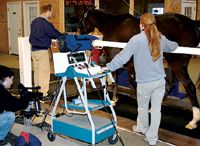Virginia Tech equine medical center offers new gait-analysis system
The technology will help many patients, but will be of particular benefit to athletic horses.
LEESBURG, VA. — A new high-speed digital video system that will allow for detailed gait analysis, lameness diagnosis and hoof balancing in horses is expected to go into operation this month at Virginia Tech's Marion duPont Scott Equine Medical Center.
Unlike most video cameras, which could only capture horses in motion at 30 frames per second, the new technology can film at 60 frames per second in high definition, permitting the center's specialists to clearly view foot landing, breakover and arc of the foot, and limb flight.
Using an equine treadmill that offers graded exercise in a controlled environment, a horse's gait can be captured at both varying and consistent speeds. The footage can then be frozen in still frames or played in slow motion, allowing for precision viewing of movements.
Treadmill and imaging devices are in use at other university equine hospitals, but this is believed to be the first one that provides high-resolution digital imaging and the ability to freeze frames for viewing.
The $300,000 system underwent testing at the center since last October. Horses from the nearby Loudoun Therapeutic Riding Foundation in Leesburg, Va., a nonprofit organization that provides horseback riding and related activities for therapeutic purposes for children and adults with disabilities, participated in the testing.
"We are thrilled by the possibilities offered by this new technology," says Dr. Nat White, Jean Ellen Shehan Professor and director of the equine medical center. "The benefits of slowing or freezing high-quality digital images of a horse at full gallop are endless."
According to Dr. Curry Keoughan, DVM, Dipl.ACVS, clinical assistant professor in equine lameness and surgery, using video technology rather than analog film also may result in enhanced performance through more accurate therapeutic shoeing.
"Previous gait-analysis systems were based on computer images that were sometimes misleading," Keoughan says. "This system will enable us to optimize hoof balance and comfort, leading to heightened performance and success."
Keoughan notes the new technology will be of particular benefit for athletic horses. "To improve productivity by even half a percent in a race horse is very significant," he says.
The center is a full-service equine hospital owned by Virginia Tech and operated as one of three campuses that comprise the Virginia-Maryland Regional College of Veterinary Medicine.

Right in step: A horse undergoes gait analysis during testing of a new digital-imaging system at the Marion duPont Scott Equine Medical Center in Virginia.
Podcast CE: A Surgeon’s Perspective on Current Trends for the Management of Osteoarthritis, Part 1
May 17th 2024David L. Dycus, DVM, MS, CCRP, DACVS joins Adam Christman, DVM, MBA, to discuss a proactive approach to the diagnosis of osteoarthritis and the best tools for general practice.
Listen